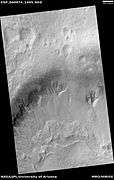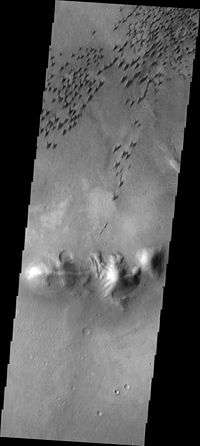Arkhangelsky (crater)
|
Arkhangelsky Crater Dunes, as seen by THEMIS. Click on image to see possible gullies on central peak. | |
| Planet | Mars |
|---|---|
| Coordinates | 41°24′S 24°48′W / 41.4°S 24.8°WCoordinates: 41°24′S 24°48′W / 41.4°S 24.8°W |
| Eponym | A.D. Arkhangelsky a Russian geologist |
Arkhangelsky Crater is a crater in the Argyre quadrangle of Mars, located at 41.4° S and 24.8° W. It is 125 km across and was named after A.D. Arkhangelsky a Russian geologist.[1]
-

Arkhargelsky Crater, as seen by CTX camera (on Mars Reconnaissance Orbiter). Dark spots are dunes.
-

Dunes in Arkhargelsky Crater, as seen by CTX camera (on Mars Reconnaissance Orbiter). Note: this is an enlargement of the previous image.
-

Old glaciers and gullies in a crater near Arkhargelsky Crater, as seen by CTX camera (on Mars Reconnaissance Orbiter). Note: this is an enlargement of a previous image. Old glaciers are the curved ridges on the floor.
-

Wide view of gullies in Arkhangelsky Crater, as seen by HiRISE under HiWish program
-

Close-up of small channels in gullies in Arkhangelsky Crater, as seen by HiRISE under HiWish program Patterned ground in the shape of polygons can be seen to the right. Note: this is an enlargement of the previous image from Arkhangelsky Crater.
-

Close-up of a gully showing a channel going across the apron, as seen by HiRISE under HiWish program. Note: this is an enlargement of a previous image from Arkhangelsky Crater.
Why are Craters important?
The density of impact craters is used to determine the surface ages of Mars and other solar system bodies.[2] The older the surface, the more craters present. Crater shapes can reveal the presence of ground ice.
The area around craters may be rich in minerals. On Mars, heat from the impact melts ice in the ground. Water from the melting ice dissolves minerals, and then deposits them in cracks or faults that were produced with the impact. This process, called hydrothermal alteration, is a major way in which ore deposits are produced. The area around Martian craters may be rich in useful ores for the future colonization of Mars.[3]
See also
- Climate of Mars
- Glacier
- Glaciers on Mars
- Impact crater
- List of craters on Mars
- Water on Mars
- Planetary nomenclature
